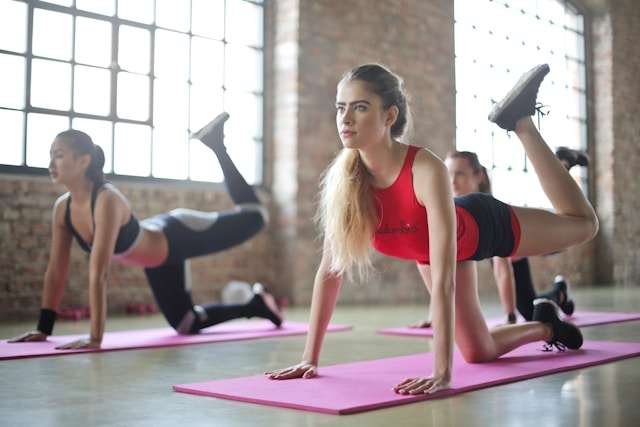
The short answer of personal trainers at MPower Fitness Coaching is that you do not need to immediately restart your workouts after having COVID-19 or other illnesses.
But, you can feel free to jump right back into your regular workout routine, no matter how intense it may seem, if your doctor and your personal trainer feel that you can handle it
The long answer is that while you don’t have to worry about starting over, some slight modifications will make things go a little more smoothly.
Keep in mind that it depends on you, the individual, and your fitness goals. If you are an athlete who will be competing soon or training for competition season, do not worry about modifying anything – keep working out as usual until your body needs a rest (for example, before competitions). Also, realize that everyone is different and may not get the same results as someone else.
If, on the other hand, your goal is to get into shape or lose weight, then there are some things you and your personal trainer do to help ease back into your exercise routine after having COVID-19.
After your post-treatment checkup you can start light exercise (walking, yoga) but not push yourself. You probably will feel like you are at about 80% of your pre-treatment strength and endurance. If you exert yourself too much while your bone marrow is still recovering, then there is a risk that your blood cells will suffer irreparable damage. That 80% is an excellent guideline to follow.

Keep in mind that it does not make much sense for you to do weight training, HIIT work, or other rigorous exercises. Your body will put a lot of pressure on your bones, and you don’t want to risk injuring them even more after having been through the whole cancer treatment process.
Even if you are feeling up to exercising, there are things that you can do right now to make your workout routine go more quickly. By focusing on some simple techniques and features of your workouts, you will be able to erase the time gap between receiving treatment for cancer and beginning a healthy regimen of exercise or any other fitness program.
The first thing you can do to make your workouts go more easily is focus on proper exercise gear. The suitable workout wear makes a big difference, and comfortable clothes will help you stay focused on exercising, not pulling or pinching or discomfort of any kind.
A good pair of workout pants, for example, is going to be very soft against your skin. You will not be tugging at them constantly to get more comfortable or adjusting the waistband of your pants because they are too tight. Choose something that is very stretchy, so you can move all around in it without having to change clothes after every exercise session. Matching tops, like sports bras and tanks with built-in bras, are also excellent choices. You do not have to worry about feeling constricted in the right places, so you will be free to focus on getting your work done without distractions.
If comfort is not enough for you, consider how good your workout clothes are at helping you sweat. Cotton is not a very good material for clothing that you will be sweating in, and it can dry up and not allow for proper circulation, leaving you with a squishy feeling in your body and your clothes. Polyester and spandex are much better fabrics in this regard: they will keep your skin from getting too damp so that you do not feel stuck in the workout gear.

Next is to focus on your exercise routine itself. When returning to a workout routine after having had COVID-19— or even surgery for that matter, make sure that you are not pushing yourself too much, or else you can risk injuring yourself.
You should start with light exercises to help get your muscles used to regular activity again. Yoga, Pilates, and other low-impact exercises are excellent choices for this.
When it comes to weights, resistance training, in particular, you should be very careful. If you feel up to barbells or dumbbells, keep the weight light when starting and increase slowly over time. Your personal trainer here at MPower Fitness Coaching will give you a light routine at the beginning.
Your muscles will have to work harder. If you are not allowing them enough time to adjust, you can significantly increase your risk of getting injured.
You should also focus on keeping the intensity low and avoid high-impact exercises like running or jumping rope. Get into low-impact activities like skating or cycling instead.
If you believe that you are up to it and your doctor approves, ask your personal trainer to ease you into high-intensity workouts after completing your treatment.
We tell our clients at MPower Fitness Coaching, the main thing is not how often you exercise or for how long; instead, focus on making sure that when you begin exercising again, all of your muscles get equal attention and work in the same way as before.

When returning to your workouts, remember that you should always listen to your body and take it easy when needed. Your body has just had major surgery and treatments, so it needs time to rest properly before you jump back into more rigorous activities. Never push yourself too much or start with too intense of a workout routine.
Your personal trainer will recommend that you opt for low impact, low-intensity workouts until you are 100% sure that your body can handle more.
When it comes to running after having COVID-19, you should wait for medical approval before doing so. You will need a clean bill of health from your doctor before you begin pushing yourself again. When returning to high-impact exercises like running after having COVID-19, you should take your time and gradually ease back into it. You want to avoid injuring yourself in your haste to return to the activities that you enjoy.
Instead, begin with activities like biking and taking walks before you attempt running. Once you are sure that all parts of your body are up to the increase in activity levels, slowly work yourself into a comfortable position for running. Increase how much you run at each exercise session over time until you are ready to begin rerunning full marathon distances.
Exercise is a great way to help you stay healthy, especially after having COVID-19. The key is never pushing yourself too hard and listening to your body when beginning a new exercise routine.
Remember that having had COVID-19 does not necessarily mean that you cannot do rigorous workouts or high-impact exercises like running or sprinting.
You should always listen to your body, and your MPower Fitness Coaching personal trainer if there is any pain or discomfort. Take a break if needed.